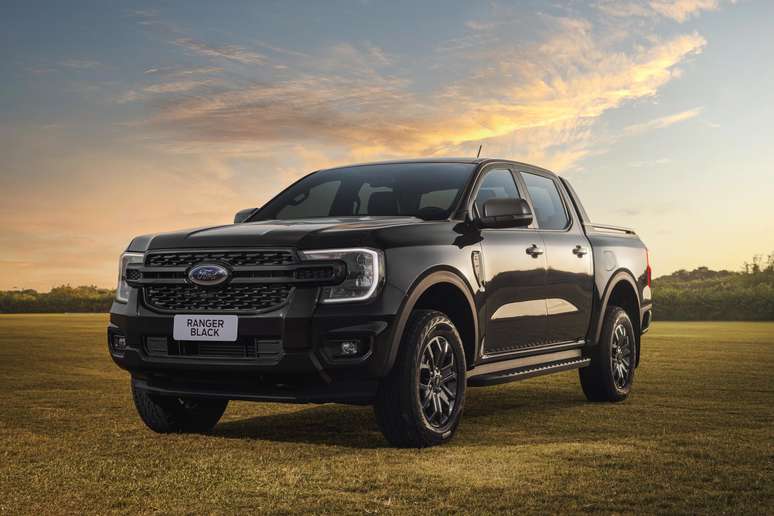The Argentinian-made Ford pickup replaces the previous XLS version and the price of R$ 219,990 puts the Ranger Black in a prime position
Ford’s entry-level midsize pickup received minor trim improvements, especially in the interior, in addition to exterior trim elements. It replaces the previous XLS version and the price of R$219,990 puts the Ranger Black in a privileged position compared to its direct competitors.
It has kept the 4×2 specification unchanged, the six-speed automatic transmission and the same 170 hp and 41.2 kgf·m diesel engine, now also produced in Argentina, which tends to help reduce costs.
Inside, the steering wheel is covered in leather. The seats do not receive this material, but it has improved the appearance and durability of the upholstery. With a humorous detail on the sides of the front seats of Henry Ford’s famous English phrase: “So long as it’s black”.
He was referring to the fact that at the beginning of the 20th century the customer could choose any body color, as long as it was black. In addition to standardization, the paint dried faster. Despite the name Black, the body colors are not limited to black: it can also be white, silver and blue.
Basalt, third Citroën novelty, tuned to the market
Coupe SUVs have attracted attention and the Basalt is aimed at this segment. It’s not exactly an SUV, but rather a crossover. But it manages to differentiate itself from the Fiat Fastback, both Stellantis products. There is a balance of lines, with emphasis on the large rear lights that extend to the sides, the headlight cluster and the curvature of the roof.
Wheelbase, 2,645 mm (guarantees good interior space, especially for heads in the rear seats); length, 4,343 mm; width, 1,821 mm and height, 1,585 mm. The trunk capacity is also very good, equal to 490 L, slightly lower than that of the Fastback (516 L).
The engine is the same Fiat, 1 L turbo, 130 HP, 20.4 kgf·m (ethanol or petrol) and also the same seven-speed CVT transmission. The factory specifies acceleration from 0 to 100 km/h in 8.4 s. This equipment proved to be suitable for urban and motorway use, with immediate responses to the accelerator, well-sized brakes and precise steering during the first evaluation between Sao Paulo and Fazenda Capoava, in Itu (SP).
The steering wheel position, with good center definition, suffers from the lack of reach adjustment and undamped height adjustment (free fall). The suspension is firm, maintaining comfort on uneven pavement, neither too hard nor too soft, within the high standards of Brazilian engineering in general.
The safety package, while reasonable, leaves out expensive items like LED headlights and forward collision warning. On the other hand, it has competitive prices between R$89,900 and R$107,390.
Hyundai Creta 2025 gets the first deeper update
The harmony of the lines marks the first major aesthetic change of the second generation, which appeared three years ago. Grille, bumper, headlights and a side-to-side LED strip show off a completely new front end.
At the rear, the 2025 Creta has received visually striking interconnected lights, which are complemented by a redesigned bumper. There are new diamond-cut alloy wheels. Inside there are two integrated 10.25-inch screens. The Ultimate and N-Line versions were released at the same time.
The external dimensions have been maintained with a symbolic variation of 20 mm in length. Mechanically, the new 1.6 turbo and direct injection engine replaced the previous 2-litre naturally aspirated engine in good time. It now delivers 193 hp and 27 kgf·m, only in the petrol version. The transmission is a seven-speed automatic with two clutches.
In the first evaluation at Itu (SP), with the single most powerful engine among all compact SUVs on the market, the gearbox is very surprising with immediate responses and acceleration from 0 to 100 km/h in just 7.8 s. Great cornering stability. Noise level, another strong point of the Creta’s new engine. The safety systems (ADAS, in English), tested separately, corresponded to expectations.
Prices maintained: from R$141,890 to R$182,090. Only in the top Ultimate version, with the new engine, additional R$2,000 (R$189,990)
BMW invests R$ 1.1 billion and confirms the plug-in hybrid
Already last April the German manufacturer had announced that it would produce the country’s first premium plug-in hybrid here, on the occasion of the celebrations for 10 years since the installation of the Araquari (SC) plant. Now, in addition to revealing the investment of R$ 1.1 billion, between 2025 and 2028, it has confirmed the start of production of the X5 plug-in hybrid in the petrol version.
Currently imported from the USA, domestic production of the medium-large SUV is expected to begin in November. Milan Nedeljković, head of production and member of BMW’s global management, came to Brazil from its headquarters in Munich to announce the disbursement and the start of sales in the coming weeks.
The director also did not rule out a future flexible hybrid version which would be in the plans, if there is demand. BMW has already experimented with this development since its first engines of this type, designing the ethanol sensor next to the injection system, which is much more precise and reliable than the one commonly used after the catalyst.
There is also the intention to produce other models in the country and also hybrids, as confirmed by the president of the local operation Maru Escobedo. A competitive advantage of the Bavarian German brand is that it uses the same bodywork to offer cars with combustion, hybrid and electric engines. This was also recognized by the American newspaper The New York Times, stating that the strategy had an effect on sales, which competitors doubted.
However, BMW has already presented prototypes of a sedan and a crossover specifically for electric powertrains. Neue Klasse (New Class) is expected to debut by 2026.
Source: Terra
Rose James is a Gossipify movie and series reviewer known for her in-depth analysis and unique perspective on the latest releases. With a background in film studies, she provides engaging and informative reviews, and keeps readers up to date with industry trends and emerging talents.






